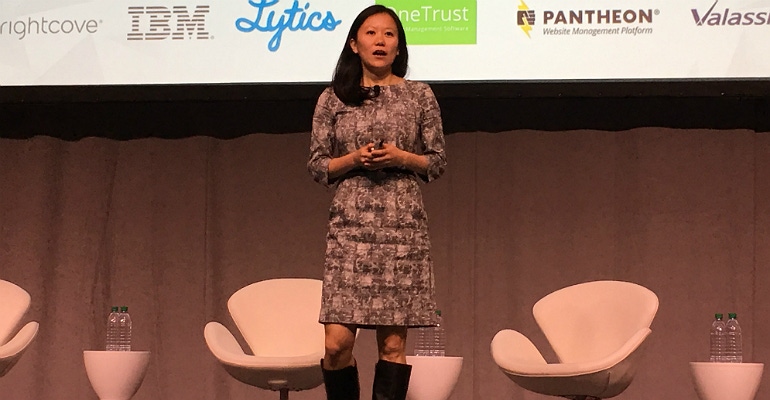Channel partners well-versed in digital marketing, artificial intelligence and customer data platforms will lead the way to one-to-one marketing.

(Pictured above: Topbots’ Adelyn Zhou on stage at MarTech Conference in San Jose, California, April 25.)
First, a little test. Consider the following passage:
“Kitty couldn’t fall asleep for a long time. Her nerves were strained as two tight strings, and even a glass of hot wine, that John made her drink, did not help her. Lying in bed she kept going over and over that monstrous scene at the meadow.”
Was this written by artificial intelligence (AI) or a human?
“This was written by a computer in St. Petersburg in 72 hours,” says Adelyn Zhou, CMO at Topbots, a community for enterprise AI executives, speaking to marketers at the MarTech Conference in San Jose, California, this week. “As we get better and better over time, you’ll see more and more things written by computers. And now you have tools of copy generation that are helping people – marketers like us – create better headlines, better topics, things like that.”
This is just the tip of the iceberg for AI in marketing. AI has evolved quickly over the last few years and is now the heartbeat of marketing tech. According to the 2018 marketing technology vendor landscape report unveiled at the MarTech Conference, AI has become embedded in every major marketing tech system to the point where standalone, predictive analytics tools are disappearing.
Digital marketers now find themselves in a hotly contested race to get AI to deliver on marketing’s great promise of personalization — a feat that spans discovery, content creation and delivery.
For instance, AI can mine videos, images and reviews, and learn how each customer feels about a product at a speed and scale that’s impossible for a human to do. It can create hyperpersonalized content that looks like it came from a human. And it can deliver the right content to the right person at the right time through, say, a conversational bot, which also mimics a human.
“After many years of extravagant promises and monumental disappointments, AI is finally starting to produce real-life returns for early adopting companies,” says Jason Heller, partner, global lead, digital marketing operations and technology at McKinsey & Company. “It might be clunky in some instances, but it’s here.”
Of course, it’s equally important to note that AI isn’t something marketers can do on their own – “You can’t be Don Quixote,” Heller says. AI’s underlying technology challenges loom large, especially concerning systems with customer data, which AI needs to train on.
Many marketers will no doubt turn to channel partners for help. A channel partner can assess a marketing tech vendor’s embedded machine learning model, implement a customer data platform, integrate customer data silos, and continuously tune AI to yield the best results.
Here’s just one example of the power of AI in marketing, courtesy of Zhou:
She says a popular consumer product, say, L’Oreal Revitalift night cream, might have hundreds of online reviews on Amazon and elsewhere, making it impossible for a human to process and distill meaningful insights. For AI, though, processing this data isn’t that difficult.
Distilling meaning is also becoming easier through advancements in AI.
Let’s say AI runs across a review from someone named Tyler, who writes: “I recognize that this product is made primarily for and definitely marketed to women. However, hear me out here, as a guy in his late twenties who’s beginning to notice appearance of fine wrinkles around the eyes and on the forehead, Revitalift night cream knows no gender.”
An AI sentiment analyzer can tell that Tyler is joyful and happy about the product. His language style shows he’s analytical, socially open and extroverted. These psychodemographics flag him as a potential product advocate and inform the type of marketing campaign to reach him. AI can also create the message that will most likely appeal to Tyler — that is, analytical language about the product’s benefits.
“Instead of having to review millions of these individually, you can use text sentiment to figure that out,” Zhou says. “You can also use Pinterest and image-recognition techniques to figure out what type of mood board your different customers like and then intelligently recommend products that fit their style. Those are some of the different ways that you can use machine learning and apply them fundamentally to your marketing.”
Before any of this happens, AI needs customer data to train on. Here’s where the channel partner comes in.
Someone needs to stitch together multiple data sources – terabytes, perhaps petabytes of data – in a way that allows AI models to predict the attributes of a product and offer a personalized customer experience, McKinsey’s Heller says. This means unifying every customer interaction from all sorts of places, such as mobile, web click stream, offline and online sales transactions, internet-of-things sensor data and CRM data, into a customer data platform.
“You now will have the ability at an individual level to take that promise that we’ve had as marketers for God knows, 20-plus years, of real, one-to-one marketing, and actually be able to use signals to determine what is the propensity of a particular individual to purchase a product based on the attributes of that product, the channel that they’re in [and] the sequence of how they’ve been engaged,” Heller says.
About the Author(s)
You May Also Like


